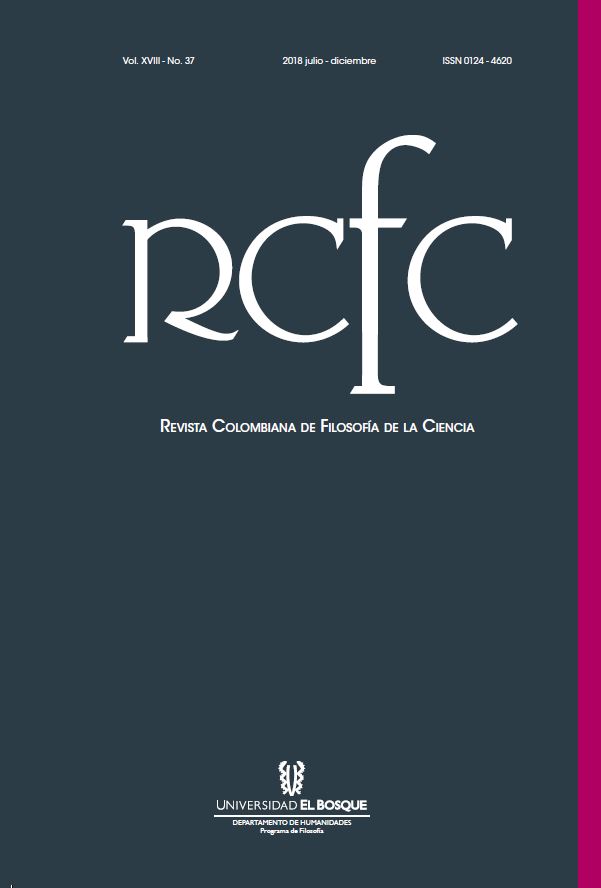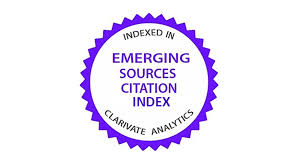Imágenes en la explicación del comportamiento prosocial humano y su evolución
DOI:
https://doi.org/10.18270/rcfc.v18i37.2576Palabras clave:
comportamiento prosocial, comportamiento prosocial, imágenes de la ciencia, imágenes de la ciencia, imágenes de la naturaleza, imágenes de la naturaleza, selección de grupo, selección de grupoResumen
En este texto rastreamos las imágenes implícitas en la explicación del comportamiento prosocial humano y su evolución, que han direccionado por más de un siglo y medio el pensamiento evolutivo y han generado una influencia dramática en la manera en que se estudia y evalúa el conocimiento de organismos unicelulares, multicelulares, colonias y sociedades. Con el trabajo historiográfico de identificar las imágenes de la naturaleza y las imágenes de la ciencia en las explicaciones sobre la evolución de la cooperación y el altruismo se logra, en parte, reconstruir la actividad científica y entender la dinámica de las teorías imperantes, y su incidencia en el surgimiento y desarrollo de explicaciones alternas a la ortodoxia como la selección de grupo.
Descargas
Referencias bibliográficas
Abrantes, Paulo. “Analogical reasoning and modeling in the sciences”. Foundations of Science 4.3 (1999): 237-270. <http://repositorio.unb.br/handle/10482/13751>. Traducción en español: “Razonamiento analógico y modelado en las ciencias”. Psicología cognitiva y filosofía de la mente: pensamiento, representación y conciencia. Eds. Duarte, A. Eduardo, R. (orgs.). Buenos Aires: Alianza, 2003. 55-98.
______. “Models and the Dynamics of Theories”. Philosophos 9.2 (2004): 225-270.
______. “Conflito e cooperação na evolução humana”. Ciência & Ambiente 48 (2014): 289-301. <http://repositorio.unb.br/handle/10482/19401>.
______. Imagens de natureza, imagens de ciência. 2.ª ed. Rio de Janeiro: EDUERJ, 2016.
Allee, W. C. The Social Life of Animals. London: Heinemann, 1938.
Axelrod, R. y W. D. Hamilton. “The Evolution of Cooperation”. Science, New Series 211.4489 (1981): 1390-1396.
Borrello, M. Evolutionary Restraints: the Contentious History of Group Selection. Chicago: The University of Chicago Press, 2010.
Bouchard, F. “What Is a Symbiotic Superindividual and How Do You Measure Its Fitness?” From Groups to Individuality: Evolution and Emerging Individuality. Eds. Frederic Bouchard y Philippe Huneman. Cambridge: MIT, 2013.
Boyd, Robert, Herbert Gintis, Samuel Bowles y Peter Richerson. “The Evolution of Altruistic Punishment”. National Academy of Sciences of the United States of America 100.6 (2003): 3531-3535. .
Boyd, R. y P. Richerson. Culture and the Evolutionary Process. Chicago: The University of Chicago Press, 1985.
______. The Origin and Evolution of Cultures. Oxford: Oxford University Press, 2005.
Brandon, Robert N. “Biological Teleology: Questions and Explanations”. Studies in History and Philosophy of Science 12.2 (1981): 91-105.
______. Adaptation and Environment. Nueva Jersey: Princeton University Press, 1995.
Calcott, B. “The Other Cooperation Problem: Generating Benefit”. Biology and Philosophy 23.2 (2008): 179-203.
Clarke, E. “The Problem of Biological Individuality”. Biological Theory 5.4 (2010): 312-325. .
Cohen, D. e I. Eshel. “On the Founder Effect and the Evolution of Altruistic Traits”. Theoretical Population Biology 10.3 (1976): 276-302.
Corning, Peter A. Holistic Darwinism: Synergy, Cybernetics, and the Bioeconomics of Evolution. Chicago: University of Chicago Press, 2005.
Damuth, J. y Heisler, I. L. “Alternative Formulations of Multilevel Selection”. Biology and Philosophy 3.4 (1988): 407-430.
Darwin, C. El origen de las especies por medio de la selección natural. 1859. México. Universidad Nacional Autónoma de México-Academia Mexicana de Ciencia, 2009.
______. El origen del hombre y la selección en relación al sexo, I. 1871. Madrid: Ediciones Ibéricas, 1966.
Dawkins, R. The Selfish Gene. Oxford: Oxford University Press, 1976.
Dobzhansky, T. “Nothing in Biology Makes Sense except in the Light of Evolution”. The American Biology Teacher 35.3 (1973): 125–129.
Dugatkin, L. Cooperation among Animals: An Evolutionary Perspective. New York: Oxford University Press, 1997.
Dupré, Jonh y Maureen A. O’Malley. “Metagenomics and biological ontology”. Studies in History and Philosophy of Biological and Biomedical Sciences 38.4 (2007): 834-846. .
Gintis, H. “Gene-culture Coevolution and the Nature of Human Sociality”. Philosophical Transactions of the Royal Society B: Biological Sciences 366 (2011): 878-888. <10.1098/rstb.2010.0310>
Godfrey-Smith, P. Darwinian Populations and Natural Selection. Oxford: Oxford University Press, 2009.
______. “Darwinian Individuals”. From Groups to Individuality. Evolution and Emerging Individuality. Eds. Bouchard, F. y Philippe, H. Cambridge: Massachusetts Institute of Technology, 2013.
Gordon, Deborah M. “What We Don't Know about the Evolution of Cooperation in Animals”. Cooperation and Its Evolution. Comps. Kim Sterelny, Richard Joyce, Brett Calcott y Ben Fraser. Cambridge: MIT Press, 2013. 195-202. .
Griesemer, J. y Michael J. Wade. “Laboratory Models, Causal Explanation and Group Selection”. Biology and Philosophy 3.1 (1988): 67-96.
Gould, S. J., y Lloyd, E. A. “Individuality and adaptation across levels of selection: How shall we name and generalize the unit of Darwinism?”. Proceedings of the National Academy of Sciences 96.21 (1999): 11904-11909. .
Haber, Matt. “Colonies Are Individuals: Revisiting the Superorganism Revival”. From Groups to Individuality. Evolution and Emerging Individuality. Eds. Frédéric, Bouchard y Philippe Huneman. Cambridge: MIT Press, 2013. 195-218.
Hamilton, A. y C. Dimond. “Groups, Individuals, and Evolutionary Restraints: the Making of the Contemporary Debate Over Group Selection”. Biology and Philosophy 27.2 (2012): 299-312. <https://doi.org/10.1007/s10539-011-9255-5>.
Hamilton, W. D. “The Evolution of Altruistic Behavior”. The American Naturalist 97 (1963): 354-356.
______. “The Genetical Evolution of Social Behavior. I”. Journal of Theoretical Biology 7.1 (1964): 1-16.
Haldane, J. B. S. “A Mathematical Theory of Natural and Artificial Selection (Part VI, Isolation.)”. Mathematical Proceedings of the Cambridge Philosophical Society 26.2. Cambridge: Cambridge University Press, 1930. 220-230 <https://doi.org/10.1017/S0305004100015450>.
Hull, D. “Individuality and Selection”. Annual Reviews in Ecology and Systematic 11 (1980): 311-332. .
Hurford, James R. The Origins of Meaning: Language in the Light of Evolution. Studies in the Evolution of Language. Oxford: Oxford University Press, 2007.
Huxley, T. H. “The struggle for existence in human society” Evolution, Ethics and Other Essays: Preface IX. COMP. Huxley, T. Collected Essays, 1898. 195-236. <https://mathcs.clarku.edu/huxley/CE9/index.html>. (acceso 23/05/2019)
Kropotkin, P. La ayuda mutua: un factor de la evolución. 1902. Venezuela: Monte Ávila Editores, 2009.
Laland, Kevin N. y Gillian R. Brown. Sense and Nonsense: Evolutionary Perspectives on Human Behaviour. Oxford: Oxford University Press, 2002.
Lehmann, L. y L. Keller. “The Evolution of Cooperation and Altruism - a General Framework and a Classification of Models”. Journal of Evolutionary Biology 19.5 (2006): 1365-1378.
Lloyd, Elisabeth A. The Structure and Confirmation of Evolutionary Theory. 2.a ed. New York: Princeton University Press, 1988.
______. “Units and Levels of Selection: An Anatomy of the Units of Selection Debates”. Thinking about Evolution: Historical, Philosophical and Political Perspectives. Eds. Rama S. Singh, Costas B. Krimbas, Diane B. Paul y John Beatty. Cambridge: Cambridge University Press, 2001. 267-290
Matessi, C. y S. Jayakar. “Conditions for the Evolution of Altruistic Traits”. Theoretical Population Biology 9 (1976): 360-387.
McElreath, R., & Boyd, R. Mathematical Models of Social Evolution: A Guide for the Perplexed. Chicago: University of Chicago Press, 2007.
Mishler, Brent D. y Robert N. Brandon. “Individuality, Pluralism, and the Phylogenetic Species Concept”. Biology and Philosophy 2.4 (1987): 397-414.
Nowak M. A. “Evolving Cooperation”. Journal of Theoretical Biology 299 (2012): 1-8
Okasha, S. Evolution and the Levels of Selection. Oxford: Oxford University Press. 2006.
______. “Rational Choice, Risk Aversion, and Evolution”. The Journal of Philosophy 104.5 (2007): 217-235.
Pabón-Mora, N. & González, F. “La clasificación biológica: de especies a genes”. Filosofía da Biología/Filosofía de la Biología. 2ª edição. Seropédica (RJ). Eds. Abrantes, P. (Org.). Editora do PPGFIL-UFRRJ, 2018. Edición electrónica revisada y ampliada, de libre acceso: <http://nulfic.org/publicacoes/filosofia-da-biologia-filosofia-de-la-biologia/>.
Richerson, Peter J. y Robert Boyd. Not by Genes Alone: How Culture Transformed Human Evolution. Chicago: The University of Chicago Press, 2005.
Ruse, M. Charles Darwin. EE. UU.: Blackwell Publishing, 2008.
Santilli E. “Niveis e unidades de seleção e o pluralismo e seus desafíos filosóficois”. Filosofía da Biologia. Ed. Paulo C. Abrantes. Brasilia: Grupo Artmed, 2011.
Sarkar, S. Genetics and Reduction. Cambridge: Cambridge University Press, 1998.
Smith, M. J. y G. R Price. “The Logic of Animal Conflicts”. Nature 246 (1973): 15-18. <http://dx.doi.org/10.1038/246015a0>.
Sober, Elliott y David S. Wilson. Unto others: The Evolution and Psychology of Unselfish Behavior. Cambridge, MA: Harvard University Press, 1998.
Sober, Elliott y Richard C. Lewontin. “Artifact, Cause and Genic Selection”. Philosophy of Science 49.2 (1982): 157-180. .
Sober, E. The Nature of Selection. 1984. Chicago: The University of Chicago Press, 1993a. <https://www.jstor.org/stable/2185056>.
______. Philosophy of Biology. Boulder, Colo: Westview Press, 1993b.
Spencer, Herbert. The Principles of Biology. Vol. I. Eds. William y Norgate. Edinburgh: 1864.
Trivers, Robert. “The Evolution of Reciprocal Altruism. Reviewed Work: University of Chicago Press”. The Quarterly Review of Biology 46.1 (1971): 35-57. <https://www.jstor.org/stable/2822435>.
Wade, Michel J. “A Critical Review of the Models of Group Selection”. Quarterly Review of Biology 53.2 (1978): 101-114.
Wade, Michael J. “The Primary Characteristics of Tribolium Populations Group Selected for Increased and Decreased Population Size” Evolution: International Journal of Organic Evolution 33.2 (1979): 749-764. <https://doi.org/10.1111/j.1558-5646.1979.tb04727.x >.
West, S. A., A. S Griffin y A. Gardner. “Social Semantics: Altruism, Cooperation, Mutualism, Strong Reciprocity and Group Selection”. Journal of Evolutionary Biology 20.2 (2007): 415-432.
______. “Social Semantics: How Useful Has Group Selection Been”. Journal of Evolutionary Biology 21.1 (2008): 374-385.
Williams, G. C. Adaptation and Natural Selection. Princeton: Princeton University Press, 1966.
Wilson D. S. y E. O. Wilson. “Evolución ‘por el bien del grupo’ ”. Investigación Ciencia 388 (2009): 46- 57.
Wilson, D. S. “A General Theory of Group Selection”. Proceedings of the National Academy of Sciences of the United States of America 72 (1975): 143-146.
Wright, S. “Evolution in Mendelian populations”. Genetics 16.3 (1931): 97.
Wynne-Edwards, V. C. Animal Dispersion, in Relation to Social Behaviour. Edinburgh: Oliver & Boyd, 1962.
______. Evolution through Group Selection. Oxford: Blackwell Scientific, 1986.
Descargas
Publicado
Cómo citar
Número
Sección

| Estadísticas de artículo | |
|---|---|
| Vistas de resúmenes | |
| Vistas de PDF | |
| Descargas de PDF | |
| Vistas de HTML | |
| Otras vistas | |











